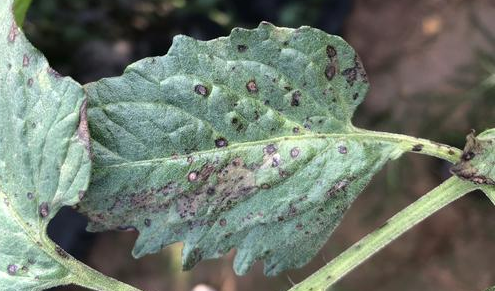Early Blight and Septoria Leaf Spot
Early blight and Septoria leaf spot are the two most common leaf spot diseases of tomatoes. While they can occur at any time during the growing season, they usually start to appear and become more severe right after blooms begin to set fruit. Both diseases are commonly found in the soil and infect the plants as the fungi splash onto the lower leaves through rain or watering. These diseases gradually work their way up the plant, slowly defoliating it. While these diseases are common, Septoria leaf spot tends to be the disease we see more in Kansas.
While both are leaf spot diseases, they are easily distinguished in the field. Septoria leaf spot will have circular, tan to gray lesions that develop on the plant's lower leaves. These lesions are typically small (less than 1/8”), but the entire leaf may become blighted as the lesions become more numerous. The lesions typically also have a dark-brown perimeter and may have a yellow halo around the spots. This disease only impacts the leaves and will not infect the fruit. Septoria leaf spot usually has smaller and more numerous spots than Early Blight. Early blight causes irregular, brown leaf spots that range in size up to 1/2” in diameter. The spots for early blight also form dark, concentric rings within the lesion, giving the spots a target-like appearance. Often, these lesions coalesce into one big spot, causing the entire leaf to turn yellow, dry up, and fall off the plant. While early blight is typically a foliage disease, lesions may develop on both stems and fruit. The fruit lesions are tan to brown, leathery, and usually originate at the fruit's stem end.
Remove any infected leaves as soon as possible to reduce the spread of the fungus to other leaves. When possible, try to water the plant from the bottom using soaker hoses rather than overhead sprinklers. Use mulch around the plants to reduce the chances that fungi can splash up onto lower leaves from the ground. Both fungal pathogens overwinter on plant debris, seeds, and surrounding weeds. To reduce the chances of disease next year, remove all plant debris at the end of the gardening year and dispose of it (don’t compost it), then remove weeds in and around the garden as much as possible. You should also rotate the tomatoes through your garden so you aren't planting them in the same spot yearly. You can spray your tomatoes with fungicides to reduce the spread of the disease; however, it won't get rid of the disease on leaves that have been infected. Use products with the active ingredients chlorothalonil or maneb to help control the disease.

Early Blight leaf spot on Tomatoes

Septoria Leaf Spot on Tomatoes

Have questions? Contact our office where our Horticulture Extension Agent will assist you with questions.
Phone: (316) 321-9660
Email: callae@ksu.edu